Secret Art of Survival - Camp Life Further Information
Artwork & exhibition information
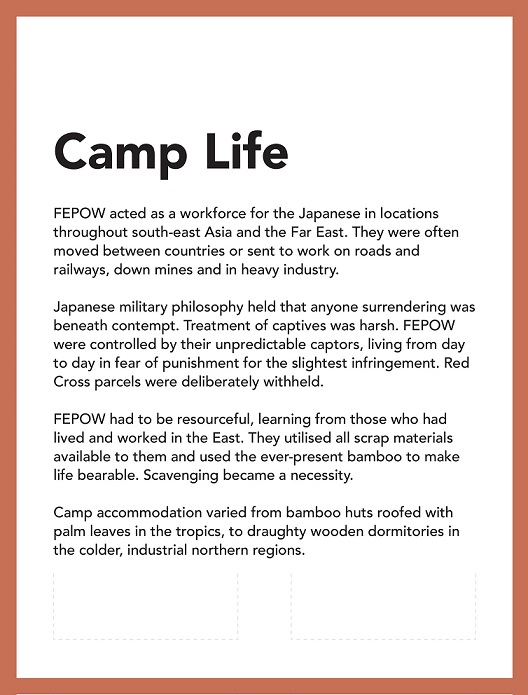
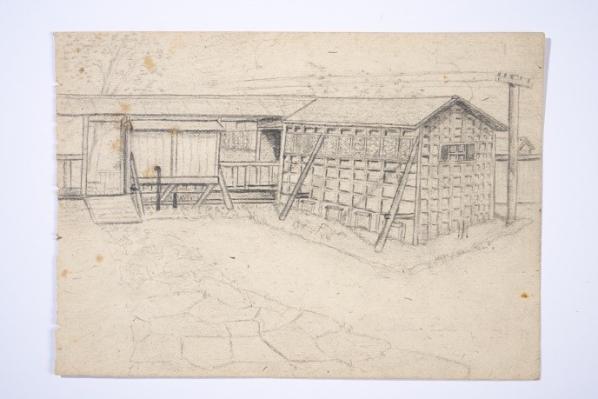
Benjo huts, Zentsuji Officers’ POW Camp, Japan, 1943
By Capt. Andrew Atholl Duncan, A&SH Regt
Pencil on paper
Loaned by M. Parkes
By Capt. Andrew Atholl Duncan, A&SH Regt
Pencil on paper
Loaned by M. Parkes
Capt. Duncan’s pencil sketch was done in November 1943 at Zentsuji, the second of three camps he was in in Japan. It shows two wooden huts built at right angles to each other. These are the benjo, or latrine, huts. A slope to the left of the picture leads up to an entrance. It appears that the benjo can be accessed from both sides as a tree is visible through the opening. What looks like a paved pathway leads to the entrance.
The huts are constructed from wood and appear quite substantial. According to his diary, they were bitterly cold during the winter.
Duncan was not an artist. He had learned technical drawing during his engineering degree course at university. He created four pencil sketches of buildings in camps and three detailed camp plans.
The huts are constructed from wood and appear quite substantial. According to his diary, they were bitterly cold during the winter.
Duncan was not an artist. He had learned technical drawing during his engineering degree course at university. He created four pencil sketches of buildings in camps and three detailed camp plans.
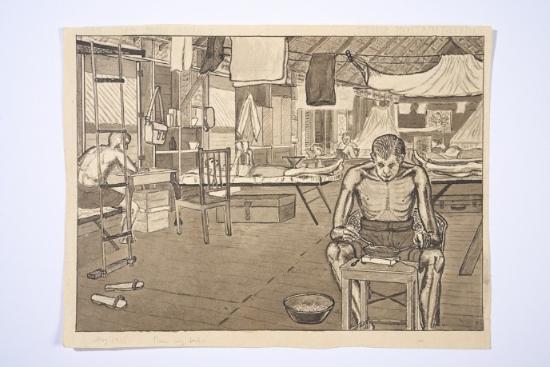
From My Bed, May 1945
By Capt. Thomas ‘Toss’ Wilson, RAMC
Ink wash on paper
Loaned by the Wilson Family
By Capt. Thomas ‘Toss’ Wilson, RAMC
Ink wash on paper
Loaned by the Wilson Family
Army medical officer, Capt. Wilson, did fourteen pen and ink and watercolour sketches while at Changi Gaol POW camp. This one depicts a spacious wooden hut, home to some of the medical officers at Changi Gaol POW camp in Singapore until liberation. New wooden huts were built around Changi Gaol to house medical staff and patients from Roberts Hospital, after Changi POW camp was cleared early in 1944.
Looking down the hut Wilson draws the viewer to the painfully thin older man facing him, cooking something on a small electric ring. Beside him on the floor is a bowl, maybe he is toasting peanuts? Across the way, a younger-looking man is seated on the lower bunk leaning on a table writing, perhaps completing medical notes? A pair of wooden clompers (homemade sandals) are at the end of his bunk. Mosquito nets are suspended over the neat camp beds stretching either side down the hut with possessions neatly stored around each bed. The occupants are reading, dozing or chatting.
Looking down the hut Wilson draws the viewer to the painfully thin older man facing him, cooking something on a small electric ring. Beside him on the floor is a bowl, maybe he is toasting peanuts? Across the way, a younger-looking man is seated on the lower bunk leaning on a table writing, perhaps completing medical notes? A pair of wooden clompers (homemade sandals) are at the end of his bunk. Mosquito nets are suspended over the neat camp beds stretching either side down the hut with possessions neatly stored around each bed. The occupants are reading, dozing or chatting.
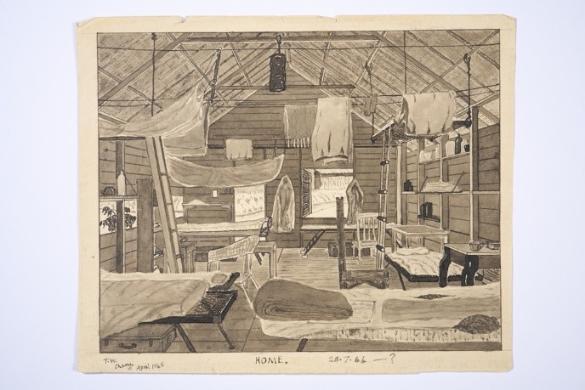
Home. 28.7.44 -?, Changi, April 1945
By Capt. Thomas ‘Toss’ Wilson, RAMC
Ink wash on paper
Loaned by the Wilson Family
Captain Wilson did a second view of the doctor’s hut, this time looking the other way from the end of his bed. He entitled it “Home”, but for how long he pondered.
The doorway is on the back wall to the left, with an open window with shutters to its right. The bunk beds on the right run along the wooden wall giving more space in this part of the room. Next to it is the small table used by the young man in the other sketch (From My Bed).
Again, mosquito nets are draped over beds and towels or sheets hang over wires slung across the hut. Clothing hangs on nails and along the wall to the left there is a narrow window with a bookcase next to it. A rattan chair creates a relaxed feel to the scene.
The doorway is on the back wall to the left, with an open window with shutters to its right. The bunk beds on the right run along the wooden wall giving more space in this part of the room. Next to it is the small table used by the young man in the other sketch (From My Bed).
Again, mosquito nets are draped over beds and towels or sheets hang over wires slung across the hut. Clothing hangs on nails and along the wall to the left there is a narrow window with a bookcase next to it. A rattan chair creates a relaxed feel to the scene.
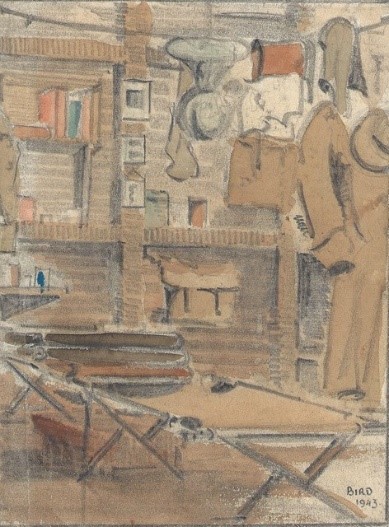
My Bed Space, Hut 10 Argyle St Officers’ Camp, Hong Kong, 1943
By Captain Godfrey Vernon Bird GM Royal Engineers
Watercolour on paper
Loaned by John Warrack (Son)
By Captain Godfrey Vernon Bird GM Royal Engineers
Watercolour on paper
Loaned by John Warrack (Son)
Argyle Street POW camp was a P.O.W. officers’ camp. The bed space referred to was not the artist’s but that of his good friend, medical officer Alexander (“Sandy”) Warrack RAMC. Bird gave this small watercolour to Warrack as a birthday present in December 1943. The building he was in appears more substantial than the bamboo huts in the tropics. He had a camp bed and his possessions are neatly stored with his clothing hanging on nails. It is a somewhat homely scene.
Godfrey Bird trained as an architect and was based in Hong Kong during the 1930s. In captivity he produced from memory dozens of pencil sketches to teach history of architecture classes. Bird and three other officers secretly communicated with agents outside camp. The activity was eventually compromised and two of them were executed. Bird was tortured but survived to see the relief of Hong Kong. He was awarded the George Medal.
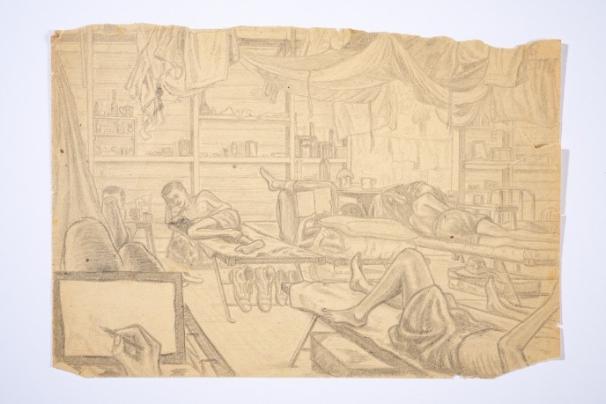
Changi Gaol, Artist Sketching
By Lt. John ‘Jack’ Wilbye Benson White, 88 Field Regt., RA
Pencil on paper
Loaned by Julie, Nicholas, and Alice Aldridge (family of the artist)
Lieutenant Jack White was captured in Singapore and held at various work camps, ending up briefly at Changi POW camp before being sent to work on the Thai-Burma railway. He returned to Changi Gaol POW camp in Singapore in December 1943. White sketched scenes from daily life throughout his captivity. In this pencil sketch, dated July 1944, he is in the process of documenting the scene looking across Hut H3 at Changi Gaol.
His fellow officers are lying on camp beds, some reading others resting. A few precious possessions are neatly stored on the hut’s wooden framework or under beds, mosquito nets are tied up out of the way. It is a relaxed scene, but there is a sense of the tropical heat that was ever present during daylight hours.
By Lt. John ‘Jack’ Wilbye Benson White, 88 Field Regt., RA
Pencil on paper
Loaned by Julie, Nicholas, and Alice Aldridge (family of the artist)
Lieutenant Jack White was captured in Singapore and held at various work camps, ending up briefly at Changi POW camp before being sent to work on the Thai-Burma railway. He returned to Changi Gaol POW camp in Singapore in December 1943. White sketched scenes from daily life throughout his captivity. In this pencil sketch, dated July 1944, he is in the process of documenting the scene looking across Hut H3 at Changi Gaol.
His fellow officers are lying on camp beds, some reading others resting. A few precious possessions are neatly stored on the hut’s wooden framework or under beds, mosquito nets are tied up out of the way. It is a relaxed scene, but there is a sense of the tropical heat that was ever present during daylight hours.
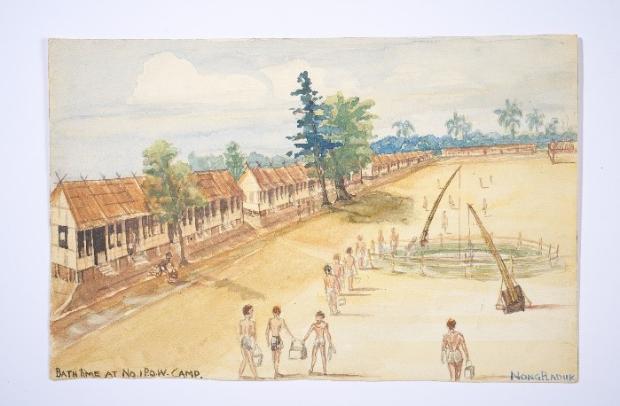
Bath Time at No.1 POW Camp, Nong Pladuk, Thailand
By Private Basil Elvin Ferron RAMC
Watercolour on paper
Loaned by S. Smith
By Private Basil Elvin Ferron RAMC
Watercolour on paper
Loaned by S. Smith
Ferron gives an impression of the size of Nong Pladuk camp, which was situated on the plain of the Southern end of the Thai-Burma railway. The hills up-country form a backdrop in the far distance. Long bamboo and atap (palm leaf-tiled) huts stretch down one side meeting another row of huts in the distance. Each hut would have accommodated over 100 men. There were few trees to afford shade. In the centre, a large water hole and two long-arm bamboo pumps with buckets attached. This provides water for the men queuing with buckets, collecting water for washing.
About the Artist:
In Chapter 7 of his e-book about FEPOW entertainments and entertainers, Captive Audiences: Captive Performances, Sears Eldredge notes that Basil Ferron was one of the well-known female impersonators in camps in Singapore and Thailand. An Anglo-Indian who was an RAMC medical orderly, Ferron was first involved in entertainments while working at Robert’s Hospital, Changi. Due to his short stature and slim physique, sleek, dark curly hair and his fine, almost feminine facial appearance, from the outset he took the leading lady roles. Ferron spent two years at Nong Pladuk before being moved north to Ubon Camp in Thailand.
About the Artist:
In Chapter 7 of his e-book about FEPOW entertainments and entertainers, Captive Audiences: Captive Performances, Sears Eldredge notes that Basil Ferron was one of the well-known female impersonators in camps in Singapore and Thailand. An Anglo-Indian who was an RAMC medical orderly, Ferron was first involved in entertainments while working at Robert’s Hospital, Changi. Due to his short stature and slim physique, sleek, dark curly hair and his fine, almost feminine facial appearance, from the outset he took the leading lady roles. Ferron spent two years at Nong Pladuk before being moved north to Ubon Camp in Thailand.
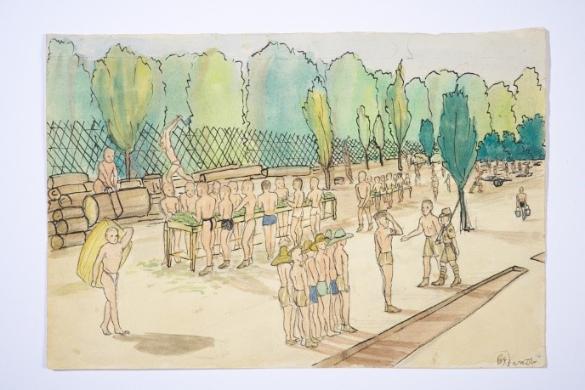
Besides the Cookhouse, Ubon, Thailand
By Private Basil Elvin Ferron, RAMC
Watercolour on paper
Loaned by S. Smith
By Private Basil Elvin Ferron, RAMC
Watercolour on paper
Loaned by S. Smith
This watercolour and ink sketch by Basil Ferron was done towards the end of captivity, at Ubon camp in northern Thailand. They were sent here to construct an airfield. It is a busy scene in what appears to be a large camp in a jungle clearing bordered by a high perimeter bamboo fence. In the centre of the picture men are lined up either side of two long tables, next to the cookhouse (not visible). On the reverse Ferron explains they are “vegetable bashing”. To the left, a man saws huge logs while another wields a large axe; in the centre foreground men are lined up ready for work party inspection. Centre right, a man carries two buckets while in the distance men are engaged in various activities.
Private Ferron was a Royal Army Medical Corps orderly. As well as his art he was also a notable and accomplished female impersonator.
Private Ferron was a Royal Army Medical Corps orderly. As well as his art he was also a notable and accomplished female impersonator.
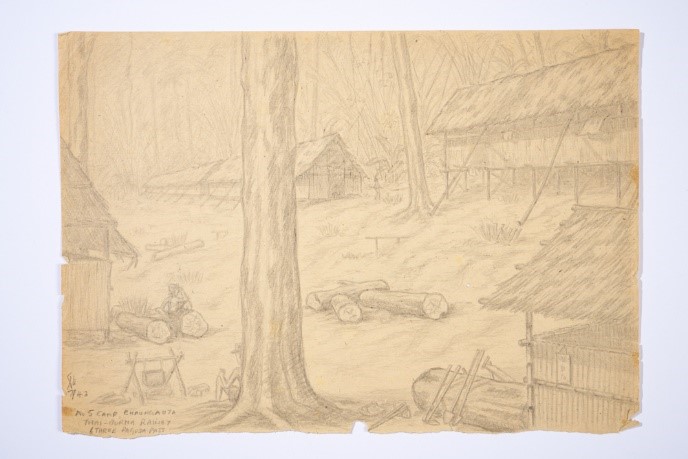
Chaungayya Camp, Burma, 1943
By Lt. John ‘Jack’ Wilbye Benson White, 88 Field Regt., RA
Pencil on paper
Loaned by Julie, Nicholas, and Alice Aldridge (family of the artist)
By Lt. John ‘Jack’ Wilbye Benson White, 88 Field Regt., RA
Pencil on paper
Loaned by Julie, Nicholas, and Alice Aldridge (family of the artist)
In April 1943 Lt Jack White was sent from Singapore to Sonkurai POW camp in northern Thailand. After three months they moved north again crossing the border into Burma (now Myanmar) to No.5 camp at Chaungayya. In July 1943 he did this pencil sketch showing the layout of the camp, with long bamboo and attap huts erected in a jungle clearing and a few tall trees left standing, providing much needed shade. To the upper right of the picture there is a bamboo hut built on stilts along an incline.
Around the camp are stacks of tree trucks awaiting chopping. In the right foreground are a collection of tools, chunkols (a type of hoe) and shovels, propped against a log next to a bamboo and attap hut. One or two men are resting in the shade near a small open fire over which a can is suspended from a bamboo frame. Perhaps a welcome brew?
This is the only illustration so far come to light of a camp inside Burma. Within a month White was moved further into Burma, to Tanbaya Hospital camp run by Australian POW doctors. He returned to Singapore in December.
Around the camp are stacks of tree trucks awaiting chopping. In the right foreground are a collection of tools, chunkols (a type of hoe) and shovels, propped against a log next to a bamboo and attap hut. One or two men are resting in the shade near a small open fire over which a can is suspended from a bamboo frame. Perhaps a welcome brew?
This is the only illustration so far come to light of a camp inside Burma. Within a month White was moved further into Burma, to Tanbaya Hospital camp run by Australian POW doctors. He returned to Singapore in December.
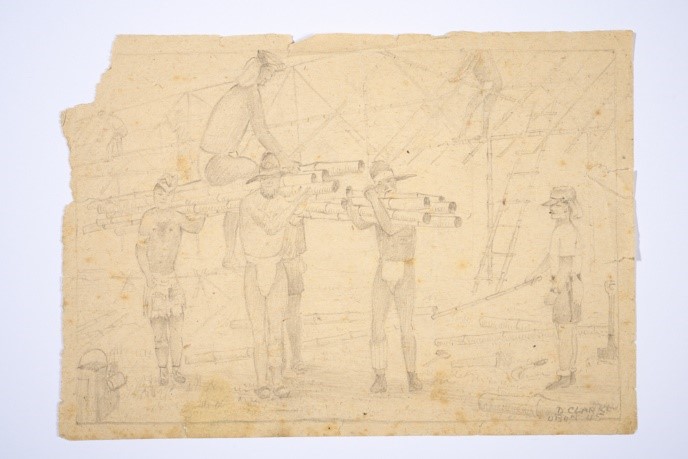
Hut Construction Working Party, Ubon POW camp, 1945
By Gunner Donovan ‘Don’ Clarke, 135 Field Regiment., RA
Pencil on paper
Loaned by Mike Clarke and Greta Palmer (artist’s children)
By Gunner Donovan ‘Don’ Clarke, 135 Field Regiment., RA
Pencil on paper
Loaned by Mike Clarke and Greta Palmer (artist’s children)
This fragile pencil sketch by Don Clarke, was created towards the end of his captivity in Thailand, after being moved north to Ubon to build an airfield. In the foreground a group of men, wearing tattered shorts or “Jap Happies” (loin cloths) are carrying bamboo poles along with one man perched on top. At least two men have bandaged legs, indicating tropical ulcers. In the distance another couple of men are up ladders working on the roof. To the left a guard supervises, with the aid of a bamboo stick. Bottom right there is a large tin can with a metal cup hooked round the handle, presumably water for when they take a break.
Don Clarke was from Oxfordshire. He enjoyed art and was encouraged at school. When he left at 13, he briefly attended Technical College before leaving to work on the farm. In his late teens he undertook an art correspondence course. His delicate and detailed sketches give a vivid account of daily life in camp.
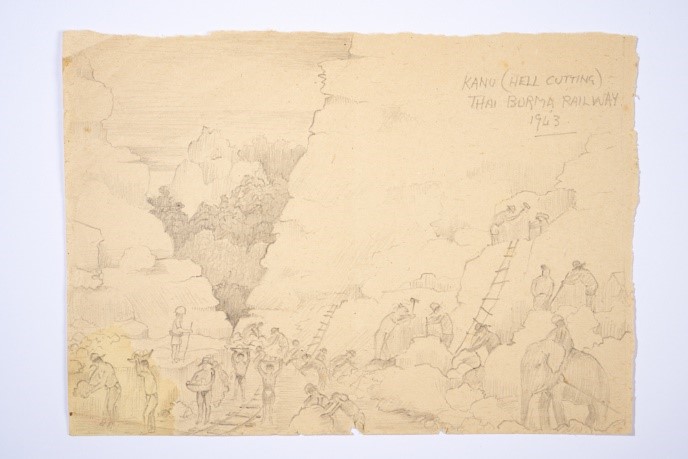
Kanu (Hell Cutting), Thai-Burma Railway, 1943
By Gunner Donovan ‘Don’ Clarke, 135 Field Regiment, RA
Pencil on paper
Loaned by Mike Clarke and Greta Palmer (artists children)
By Gunner Donovan ‘Don’ Clarke, 135 Field Regiment, RA
Pencil on paper
Loaned by Mike Clarke and Greta Palmer (artists children)
Clarke’s pencil sketch depicts the appalling working conditions POW endured in creating the Kanu cutting. Hewn from solid rock, men worked night and day through the “Speedo” period in 1943, opening up the route north for the railway.
Clarke depicts the variety of tasks carried out: men carrying baskets of rock, clearing the track bed, or rolling heavy boulders away; ladders lead to the “hammer and tap” gangs drilling holes for dynamite, high up on the rock face; an elephant, with native mahout, works bottom right hauling heavy loads.
Clarke depicts the variety of tasks carried out: men carrying baskets of rock, clearing the track bed, or rolling heavy boulders away; ladders lead to the “hammer and tap” gangs drilling holes for dynamite, high up on the rock face; an elephant, with native mahout, works bottom right hauling heavy loads.
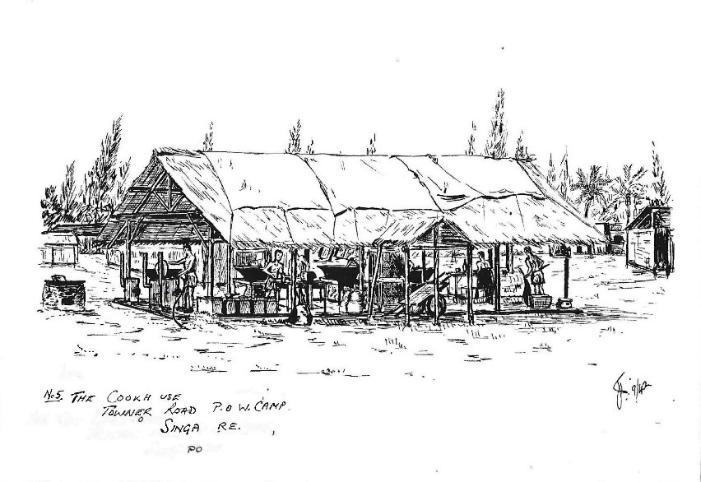
Towner Road Camp Cookhouse, 1942
By Lt. John ‘Jack’ Wilbye Benson White, 88 Field Regt., RA
Loaned by Julie, Nicholas, and Alice Aldridge (family of the artist)
By Lt. John ‘Jack’ Wilbye Benson White, 88 Field Regt., RA
Loaned by Julie, Nicholas, and Alice Aldridge (family of the artist)
Towner Road POW camp, close to the centre of town, was where Lieutenant Jack White was first held. Working parties from here cleared bomb damage or worked on the docks.
His detailed pencil sketch of the camp cookhouse shows the cooks working inside the long open-sided bamboo hut. Tarpaulins are draped over the attap (palm leaf) roof.
An earth oven, fitted with a kwali (large metal wok) for cooking rice, is seen to the left of the hut. Just inside there are three smaller ovens with metal chimneys and down the length another four large ovens with kwalis. Lined up along the long side of the hut are large metal cans, possibly for palm oil or guala malaca (a type of molasses). There is a large trolley for carrying heavy goods like the rice sacks stored nearby, and a few baskets and earthenware pots.
To date, FEPOW artists Jack White and Des Bettany are the only two known to have recorded life at Towner Road POW camp.
His detailed pencil sketch of the camp cookhouse shows the cooks working inside the long open-sided bamboo hut. Tarpaulins are draped over the attap (palm leaf) roof.
An earth oven, fitted with a kwali (large metal wok) for cooking rice, is seen to the left of the hut. Just inside there are three smaller ovens with metal chimneys and down the length another four large ovens with kwalis. Lined up along the long side of the hut are large metal cans, possibly for palm oil or guala malaca (a type of molasses). There is a large trolley for carrying heavy goods like the rice sacks stored nearby, and a few baskets and earthenware pots.
To date, FEPOW artists Jack White and Des Bettany are the only two known to have recorded life at Towner Road POW camp.